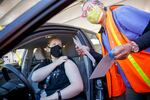
Annalisa Birt of Portland, left, prepares for her vaccination from Marlene Ikeda at a drive-thru mass COVID-19 vaccination clinic at Portland International Airport, April 9, 2021.
Kristyna Wentz-Graff/ OPB
Oregon’s seen the biggest percentage increase in COVID-19 cases of any state in the country over the past two weeks. Cases have jumped 58% in that time period, putting Oregon just ahead of Kansas and behind territories Guam and Puerto Rico.
“A few weeks ago, I came before you to say that we were concerned we would have a fourth surge of COVID-19 in Oregon,” Gov. Kate Brown said at a Friday press conference. “Unfortunately, today, that surge is here.”
Not enough people have been vaccinated and adherence to public health guidelines has fallen off a cliff, giving rise to virus transmission rates rivaling the worst days of the pandemic this winter, according to state health officials.
The Oregon Health Authority reported 1,020 confirmed and presumptive coronavirus cases Thursday, the first time the state has cracked a thousand daily cases since mid-January. The state has reported close to 800 cases a day over the past week.
Oregon state epidemiologist Dr. Dean Sidelinger called it the “most pessimistic scenario.” COVID-19, once again, threatens to overrun hospitals throughout the state.
“Our newest modeling indicates that the rate of transmission surpassed the most pessimistic scenario of three weeks ago,” Sidelinger said. “And if that spread continues unabated, our hospitals risk being swamped by virus-stricken patients.”
More than half the state’s counties are now considered “high risk” for COVID-19 transmission. Hotspots range from metro counties like Washington and Multnomah to more sparsely populated ones like Grant and Klamath.
Spread is so bad in some counties that they qualify for Oregon’s “extreme risk” category, in which indoor dining is banned and indoor capacity at gyms, retail stores and other businesses is extremely limited. State health officials said Friday they’re even considering a pause on elective surgeries similar to the pandemic’s early days.
Oregon had stopped using the “extreme risk” category because hospital capacity was at a place where state officials felt they didn’t need it. Now that hospitals are filling up, Oregon’s reinstating the “extreme risk” label and the restrictions that come with it.
The state’s most recent risk assessment, issued Tuesday, showed 11 counties — Baker, Clackamas, Columbia, Crook, Deschutes, Jackson, Josephine, Klamath, Linn, Marion and Polk — qualified as “extreme risk.” Oregon isn’t set to update risk levels until May 4, but Brown said Friday she could put several counties in that category as soon as next week.
“This is essentially your warning,” Brown said. “Should cases continue to rise, should we reach capacity in our hospital systems, there will be several counties moving into ‘extreme risk.’”
The governor set the threshold for reopening the extreme risk category at 300 people hospitalized with COVID-19; the state had 283 COVID-19 patients in hospitals as of Friday.
One contributing factor to the current spike in infections in Oregon is actually the state’s early success in keeping cases low. States that had rampant spread earlier in the pandemic were already working toward herd immunity by having a lot of people get sick and recover — but they also saw far more virus-related deaths as a result.
“There’s a high price to pay for natural immunity,” Sidelinger said. “What we have now is a tool that can provide that same level of protection to individuals — vaccination — without the risk of being hospitalized, without the risk of serious complications that follow COVID-19.”
The difference between a COVID-19 wave a year or even three months ago and a COVID-19 wave now is that many of Oregon’s most-vulnerable residents are protected from the worst of the disease.
Inoculation for COVID-19 has hummed along in Oregon. Half of the state’s adult population has received at least one dose, and more than 1 million Oregonians are fully vaccinated. The state also says 75% of seniors are fully vaccinated.
That’s despite a temporary nationwide pause on administration of the Johnson & Johnson vaccine due to at least six cases of extremely rare blood clots in women who received the shot.
The Centers for Disease Control and Prevention has launched an investigation into the case of an Oregon woman who died two weeks after receiving the Johnson & Johnson vaccine. The Oregon Health Authority does not know if there is a causal connection between the vaccine and the woman’s death.
The CDC and the Food and Drug Administration on Friday lifted the pause at the recommendation of a federal vaccine panel. The vaccine will carry a warning on the label about the exceedingly rare instances of blood clots.
Vaccines from Pfizer-BioNTech and Moderna have remained available throughout the pause and thousands of Oregonians are getting vaccinated each day.
Oregon Health Authority director Patrick Allen said that, at the state’s current daily inoculation rate, 80% of Oregon adults could receive a first dose of vaccine by July 4.
“Sustaining that pace depends on Oregonians continuing to choose to get vaccinated,” Allen said.
Oregon has reported more than 178,000 coronavirus cases since the pandemic began and 2,484 related deaths.
See the press event in the video player below.
